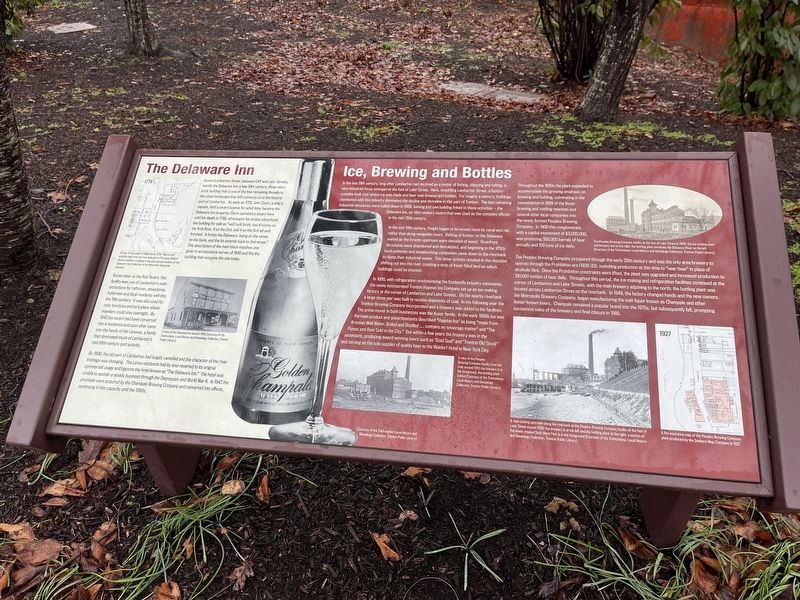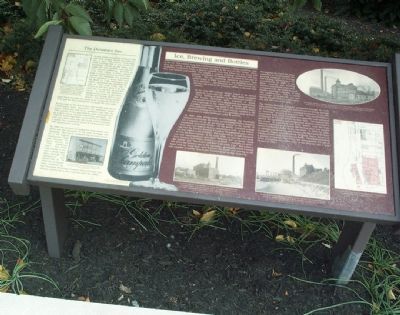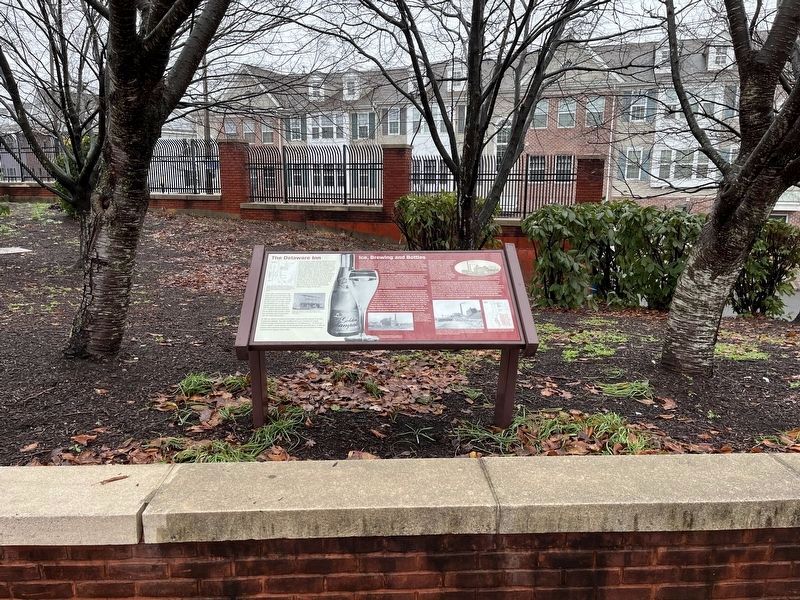South Trenton in Mercer County, New Jersey — The American Northeast (Mid-Atlantic)
Ice, Brewing and Bottles
In the late 19th century, long after Lamberton had declined as a center of fishing, shipping and rafting, a new industrial focus emerged at the foot of Lalor Street. Here, straddling Lamberton Street, a factory complex took root where ice was made and beer was brewed and bottled. For roughly a century, buildings connected with this industry dominated the skyline and shoreline in this part of Trenton. The last remaining industrial structures were pulled down in 1998, leaving just one building linked to these activities – the Delaware Inn, an 18th-century tavern that was used as the company offices in the mid-20th century.
In the mid-19th century, freight began to be moved more by canal and rail, rather than along navigable rivers. Rafting of lumber on the Delaware waned as the forests upstream were denuded of wood, Riverfront structures were abandoned and demolished and beginning in the 1850s local potteries and metal-working companies came down to the riverbank to dump their industrial waste. This latter activity resulted in the shoreline shifting out into the river creating a strip of fresh-filled land on which buildings could be erected.
In 1890, with refrigeration revolutionizing the foodstuffs industry nationwide, the newly incorporated Trenton Hygeian Ice Company set up an ice-making factory at the corner of Lamberton and Lalor Streets. On the nearby riverbank a large stone pier was built to receive shipments of coal. In the following year the Trenton Brewing Company incorporated and a brewery was added to the facilities. The prime mover in both businesses was the Kuser family. In the early 1890s ice was the main product and advertisements described “Hygeian Ice” as being “made from Artesian Well Water, Boiled and Distilled …. Contains no sewerage matter” and “The Purest and Best Sold in the City.” But within a few years the brewery was in the ascendant, producing award-winning beers such as “Gold Seal” and “Trenton Old Stock” and serving as the sole supplier of quality beer to the Waldorf Hotel in New York City.
Throughout the 1890s the plant expanded to accommodate the growing emphasis on brewing and bottling, culminating in the consolidation in 1899 of the Kuser brewing and bottling interests and several other local companies into the newly-formed Peoples Brewing Company. In 1900 this conglomerate, with a capital investment of $3,000,000. was producing 350,000 barrels of beer annually and 150 tons of ice daily.
The Peoples Brewing Company prospered through the early 20th century and was the only area brewery to operate through the Prohibition era (1920-33), switching production at this time to “near-beer” in place of alcoholic fare. Once the Prohibition
constraints were lifted, the plant was upgraded and increased production to 100,000 bottles of beer daily. Throughout this period, the ice making and refrigeration facilities continued at the corner of Lamberton and Lalor Streets, with the main brewery adjoining to the north; the bottling plant was located across Lamberton Street on the riverbank. In 1949, the factory changed hands and the new owners, the Metropolis Brewery Company, began manufacturing the malt liquor known as Champale and other lesser-known beers. Champale remained a popular brand into the 1970s, but subsequently fell out of favor, prompting successive sales of the brewery and a final closure in 1986.
The Delaware Inn
Across Lamberton Street, between Cliff and Lalor Streets, stands the Delaware Inn, a late 18th-century, three-story brick building that is one of the few remaining threads in the urban landscape that still connects us to the historic port of Lamberton. As early as 1773, John Clunn, a ship’s captain, held a tavern license for what later became the Delaware Inn property. Clunn operated a tavern here until his death in 1798, whereupon his widow advertised the building for sale as “well built brick, has 4 rooms on the first floor, 4 on the 2nd, and 4 on the 3rd, all well finished. It fronts the Delaware, being on the street on the bank, and the lot extends back to 2nd street.”
Known later as the Red Tavern, this facility was one of Lamberton’s main attractions for raftsmen, stevedores, fishermen and local residents well into the 19th century. It was also used for civic functions and as a place where travelers could stay overnight. By 1840 the tavern had been converted into a residence and soon after came into the hands of the Lenoxes, a family that dominated much of Lamberton’s mid-19th-century port activity.
By 1890, the old port of Lamberton had largely vanished and the character of the river frontage was changing. The Lenox residence had by now reverted to its original commercial usage and become known as “The Delaware Inn.” The hotel was unable to sustain a steady business through the Depression and World War II. In 1942 the premises were acquired by the Champale Brewing Company and converted into offices, continuing in this capacity until the 1980s.
Erected 2004 by New Jersey Department of Transportation.
Topics. This historical marker is listed in this topic list: Industry & Commerce. A significant historical year for this entry is 1998.
Location. 40° 11.879′ N, 74° 45.49′ W. Marker is in Trenton, New Jersey , in Mercer County. It is in South Trenton. Marker can be reached from New Jersey Route 29. This marker is in South River Walk park which is built over top of Route 29. Touch for map. Marker is in this post office area: Trenton NJ 08611, United States of America. Touch for directions.
Other nearby markers. At least 8 other markers are within walking distance of this marker. c. 10,000 – 12,000 Years Ago (a few steps from this marker); Paleo-Indians (a few steps from this marker); a different marker also named Paleo-Indians (a few steps from this marker); Warming climate and rising sea levels (a few steps from this marker); c. 3,000 – 10,000 Years Ago (a few steps from this marker); Native Americans in the Archaic Period (a few steps from this marker); Quakers Lead the Settlement of West Jersey (a few steps from this marker); The West Jersey Proprietors Rule (a few steps from this marker). Touch for a list and map of all markers in Trenton.
More about this marker. The marker is in the northern half of the park closest to the main entrance at Lalor Street. It is on the right as you approach the Trenton Timeline and Arches.
Credits. This page was last revised on February 16, 2023. It was originally submitted on December 26, 2007, by Gary Nigh of Trenton, New Jersey. This page has been viewed 2,086 times since then and 65 times this year. Last updated on February 2, 2021, by Carl Gordon Moore Jr. of North East, Maryland. Photos: 1. submitted on December 18, 2022, by Devry Becker Jones of Washington, District of Columbia. 2. submitted on December 26, 2007, by Gary Nigh of Trenton, New Jersey. 3. submitted on December 18, 2022, by Devry Becker Jones of Washington, District of Columbia. • Bill Pfingsten was the editor who published this page.


